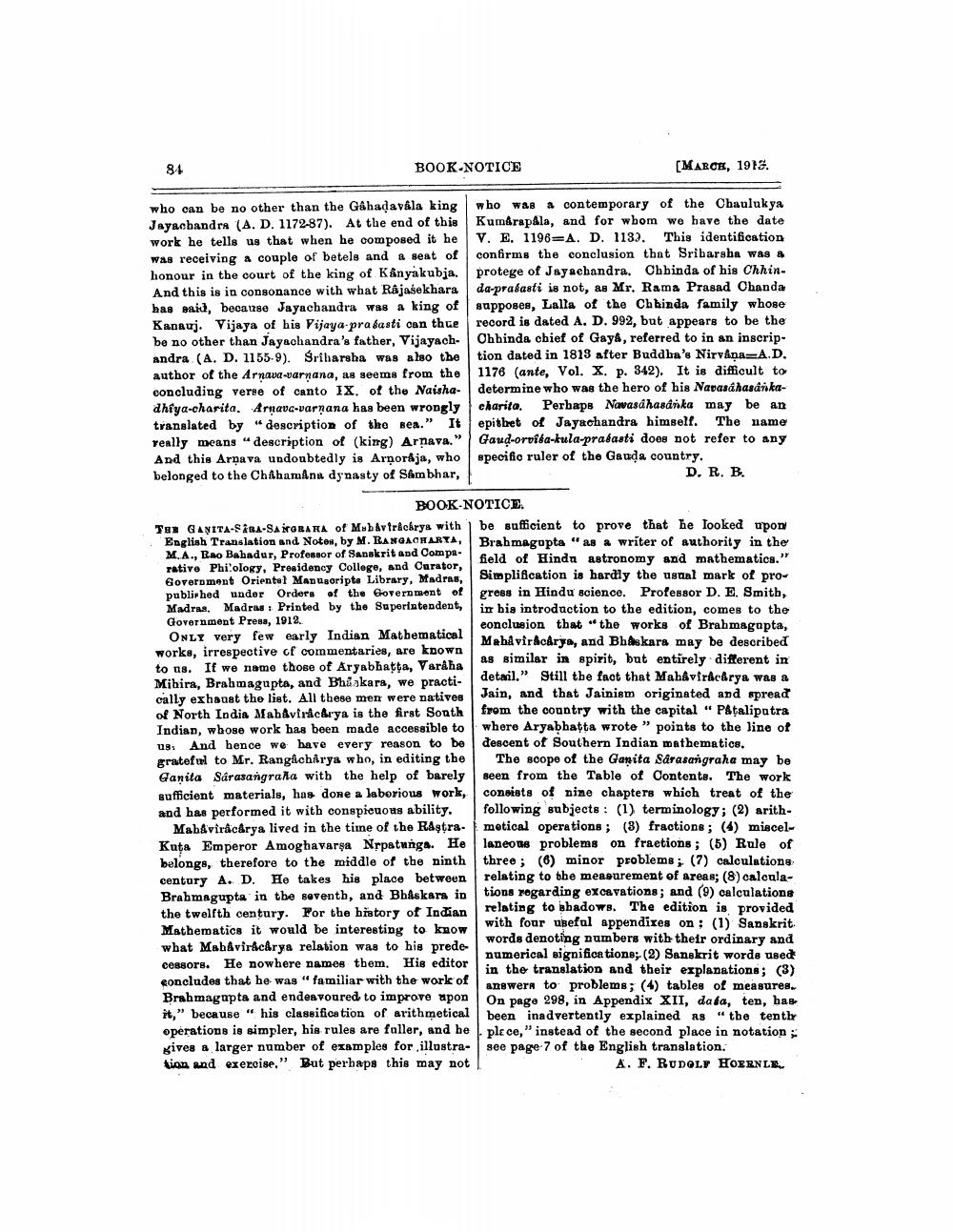________________
84
BOOK NOTICE
[MARCH, 1913.
who can be no other than the Gahadavala king who was a contemporary of the Chaulukya Jayachandra (A.D. 1172-87). At the end of this Kumrapala, and for wbom we have the date work he tells us that when he composed it he V. E. 1196=A. D. 113). This identification was receiving a couple of betels and a seat of confirms the conclusion that Sribarsha was a honour in the court of the king of Kanyakubja. protege of Jayachandra. Obbinda of his ChhinAnd this is in consonance with what Rajasekhara da-prasasti is not, as Mr. Rama Prasad Chanda has paid, because Jayachandra was a king of supposes, Lalla of the Chhinda family whose Kanauj. Vijaya of his Vijaya-prasasti can thue record is dated A. D. 992, but appears to be the be no other than Jayachandra's father, Vijayach- Ohhinda chief of Gaya, referred to in an inscripandra (A. D. 1155-9). Sriharsha was also the tion dated in 1813 after Buddha's Nirvana A.D. author of the Arnava-varnana, as seems from the 1176 (ante, Vol. X. p. 342). It is difficult to concluding verse of canto IX, of the Naisha- determine who was the hero of his Navasáhasárikadhiya-charita. Arnava-varnana has been wrongly charita. Perbaps Navasáhasánka may be an translated by "description of the sea." It epithet of Jayachandra himself. The name really means "description of (king) Arnava." Gaud-orviba-kula-prabasti does not refer to any And this Arnava undoubtedly is Arņorája, who specific ruler of the Gauda country. belonged to the ChAhamâna dynasty of Shambhar,
D. R. B.
BOOK-NOTICE. TAX GANITA-SARA-SAGRARA of Mb Avtreokrya with be sufficient to prove that he looked upon English Translation and Notou, by M. RANGACKARTA, Brahmagopta "as & writer of authority in the M.A., Rao Bahadur, Professor of Sanskrit and Compa
field of Hinda astronomy and mathematics." rative Philology, Presidency College, and Cerator, Government Oriental Manuaoripta Library, Madras,
Simplifcation is hardly the usual mark of propubliched under Orders of the Government of gress in Hindu science. Professor D. E. Smith, Madras, Madras: Printed by the Superintendent, in his introduction to the edition, comes to the Government Press, 1912.
eonolusion that the works of Brahmagapta, ONLY very few early Indian Mathematical
MahaviracArya, and Bhaskars may be described works, irrespective of commentaries, are known
as similar in spirit, but entirely different in to us. If we name those of Aryabhatta, Varaha Mihira, Brahmagupta, and Bh&akara, we practi
detail." Still the fact that Mahavirác&rya was a cally exhaust the list. All these men were natives Jain, and that Jainism originated and spread of North India Mab&virichiya is the first South from the country with the capital " Patalipatra Indian, whose work has been made accessible to where Aryabhatta wrote " points to the line of us. And bence we have every reason to be descent of Southern Indian mathematics. grateful to Mr. Rangacharya who, in editing the The scope of the Ganita Sarasanigraha may be Ganita Sarasangrala with the help of barely seen from the Table of Contents. The work sufficient materials, has done a laborious work, consists of nine chapters which treat of the and has performed it with conspicuous ability. following subjects: (1) terminology; (2) arith
Mab&viracArya lived in the time of the Raqtra-metical operations; (8) fractions ; (4) miscelKuta Emperor Amoghavarga Nrpatunga. He laneous problems on fraetions ; (5) Rule of belongs, therefore to the middle of the ninth three ; (6) minor problems; (7) calculations century A. D. He takes his place between relating to the measurement of areas; (8) calculaBrahmagupta in the seventh, and Bhaskara in
th, and Bhaskars in tions regarding excavations; and (9) calculations the twelfth century. For the history of Indian
relating to shadows. The edition is provided Mathematics it would be interesting to know
with four useful appendires on: (1) Sanskrit what MabAviracarya relation was to his prede
words denoting numbers with their ordinary and
numerical significations; (2) Sanskrit words used cessors. He nowhere names them. His editor
in the translation and their explanations; (3) concludes that he was "familiar with the work of
answers to problems; (4) tables of measures Brahmagupta and endeavoured to improve upon On page 298, in Appendix XII, dafa, ten, bas it because his classification of arithmetical been inadvertently explained as "the tentir operations is simpler, his rules are faller, and be plece," instead of the second place in notation; Kives a larger number of examples for illustra- see page 7 of the English translation. lion and exercise." But perhaps this may not
A. F. BUDOLF HOEENLE.




